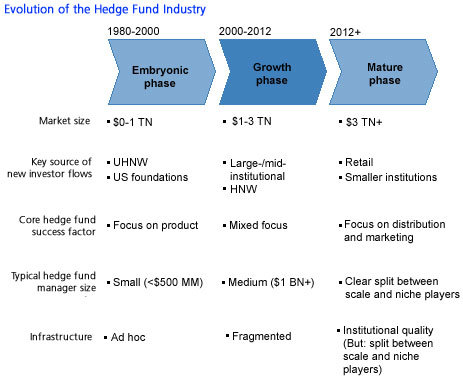Challenges and Innovation in the Hedge Fund Industry
Abstract
The hedge fund industry is slowly putting the credit crisis behind it, as it looks to new opportunities. Alpha/beta bifurcation and institutional investors’ growing appetite for hedge funds is causing a significant shift in the structural and operational underpinnings of the industry.
Fallout from the credit crisis not only revealed where the weaknesses in the hedge fund industry lie, it also highlighted the ability of some funds to navigate the current environment and vastly outperform the markets and their competition. While the versatile industry is slowly putting the credit crunch behind it, a number of structural challenges remain. In a new report, , Celent examines these challenges and presents a practical view on how the industry responds.
All signs point to the continued institutionalization of large hedge funds. Institutional investors account for an increasing percentage of the client base of hedge funds and pension funds have accelerated their push into the industry. To meet the requirements of these investors, hedge funds have developed a much more mature business model.
Asset concentration among the largest hedge funds largely reflects the changes in capital sources. "Smart money"--endowments or high net worth individuals--are gravitating toward high-profile boutique funds launched by successful portfolio managers which have the potential to generate outsized returns. New money from pension funds is gravitating towards the large, established players with more developed administration and compliance departments.
At the same time, the competition for alpha has been heating up. Circumventing the commoditization trap is one of the biggest challenges for the industry. To this end, hedge funds have become a visible and active participant in the lending business, developed more hybrid capacities and have increasingly sought to build high-capacity / low-latency smart-order routing infrastructures that will allow them to access liquidity faster, reduce market impact, increase speed and reduce trading costs.

"Risk management and operational infrastructure capabilities of large hedge funds have improved substantially. In many cases, these capabilities have begun to resemble best practices across the financial system," says Isabel Schauerte, an analyst with Celent’s Institutional Securities & Investments Group and co-author of the report.
"In fact, some large hedge funds are slowly morphing into structures more similar to traditional asset managers," she adds.
The 44-page report contains 10 figures and four tables. A table of contents is available online.
Members of Celent's Institutional Securities & Investments research service can download the report electronically by clicking on the icon to the left. Non-members should contact info@celent.com for more information.

